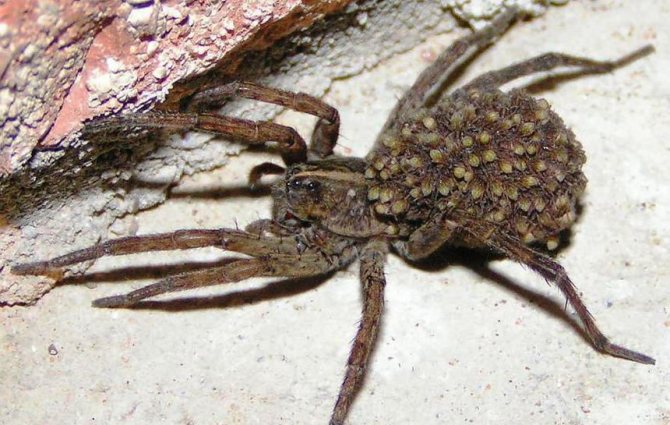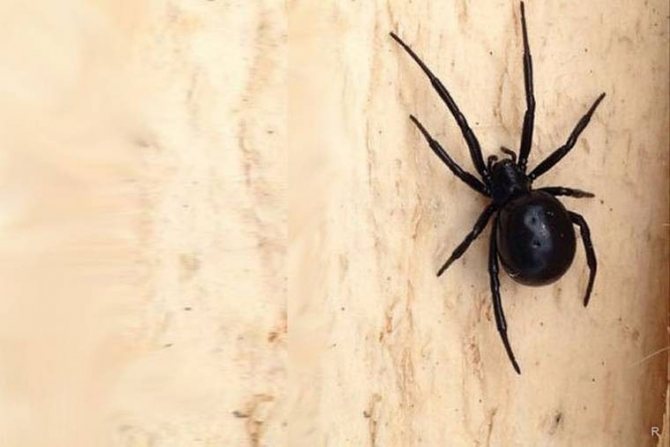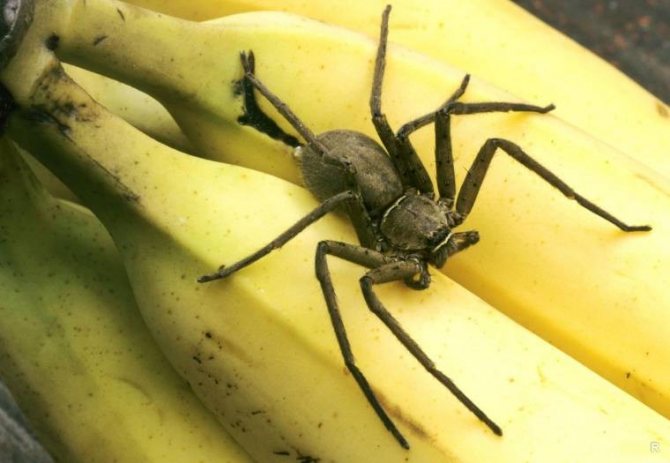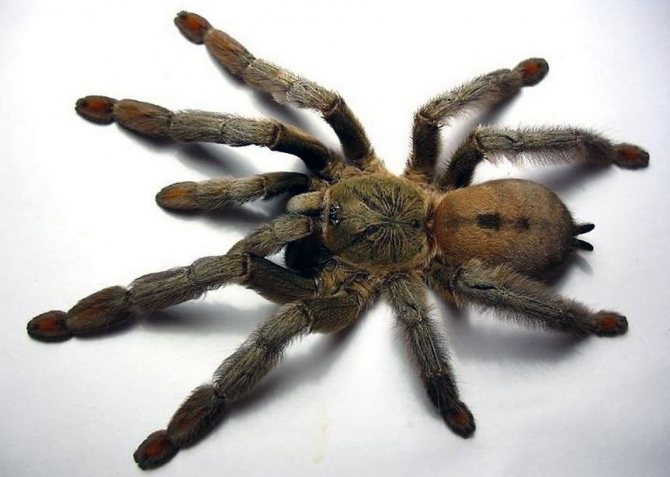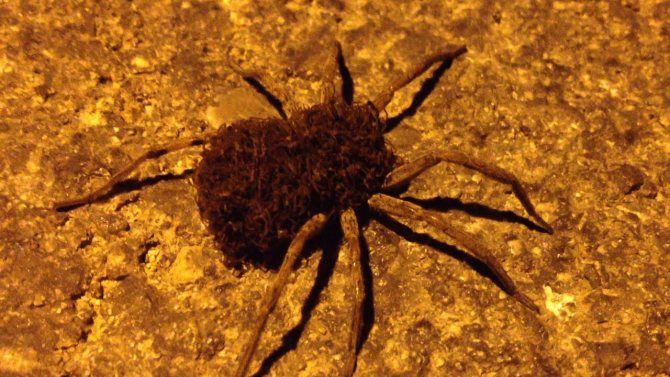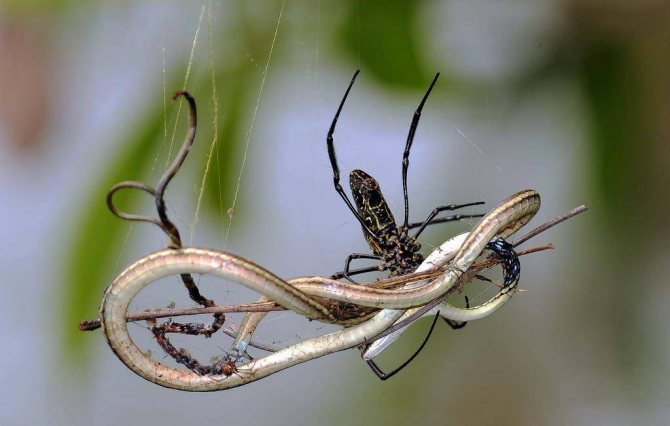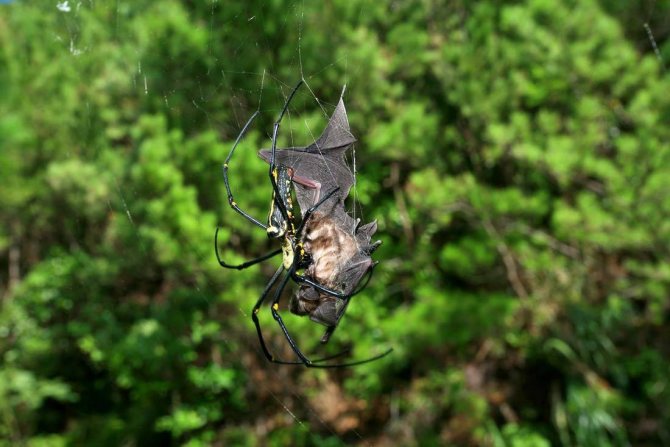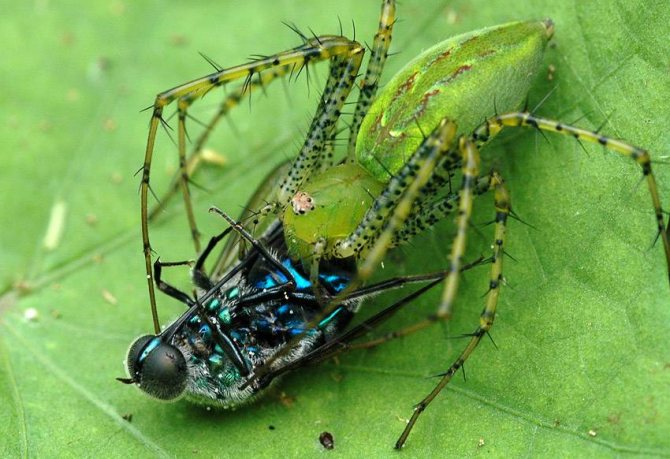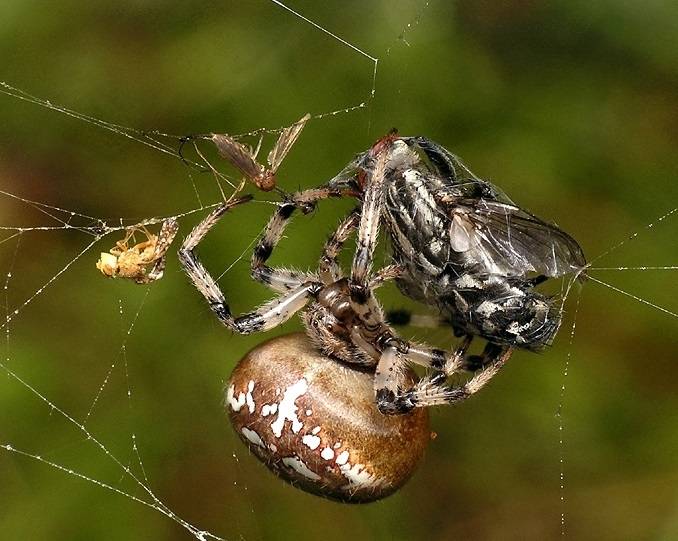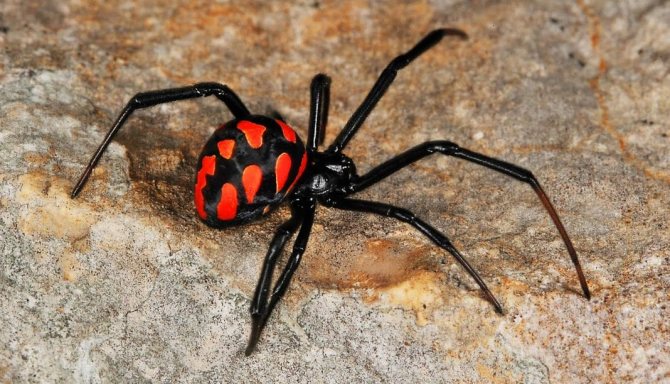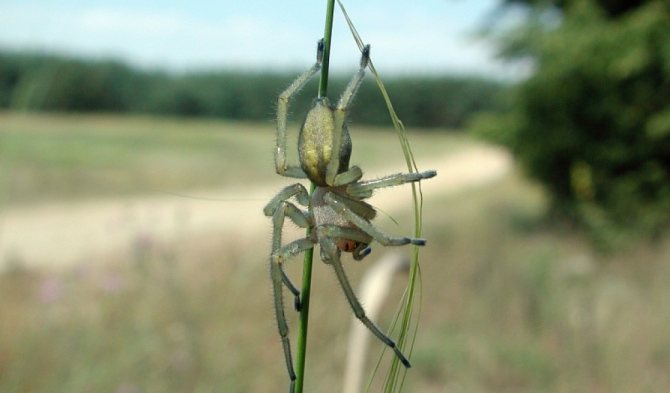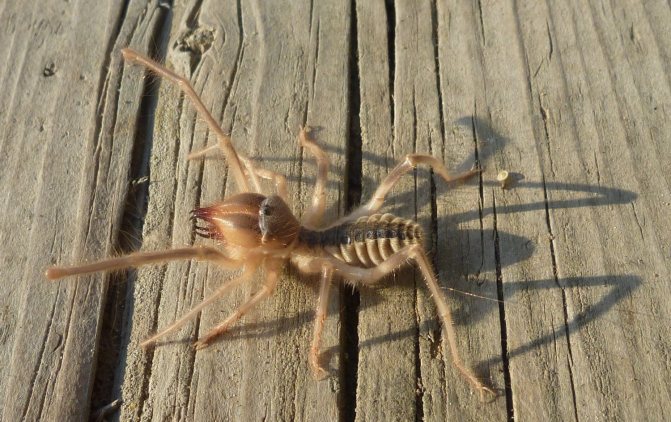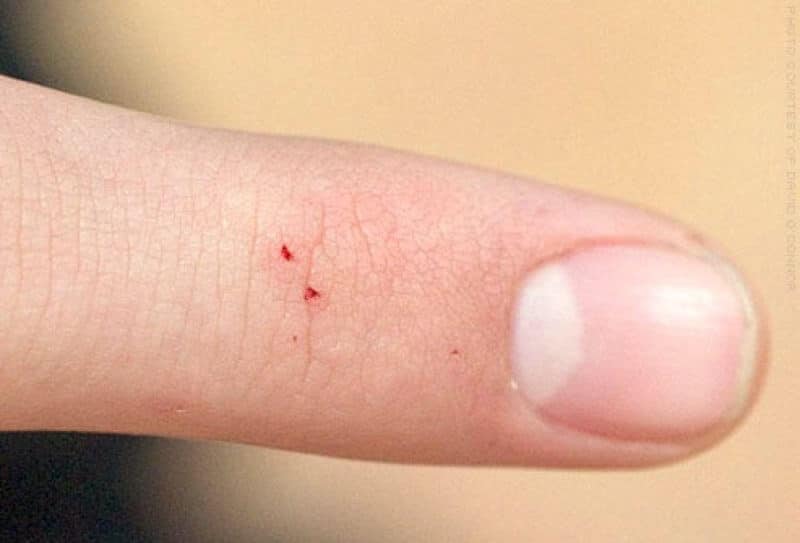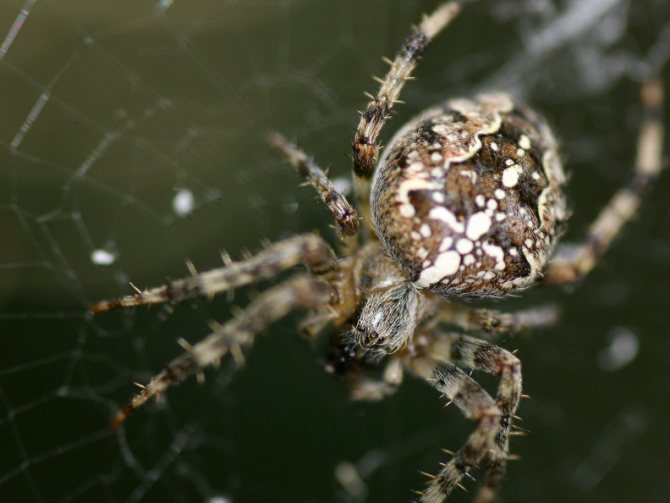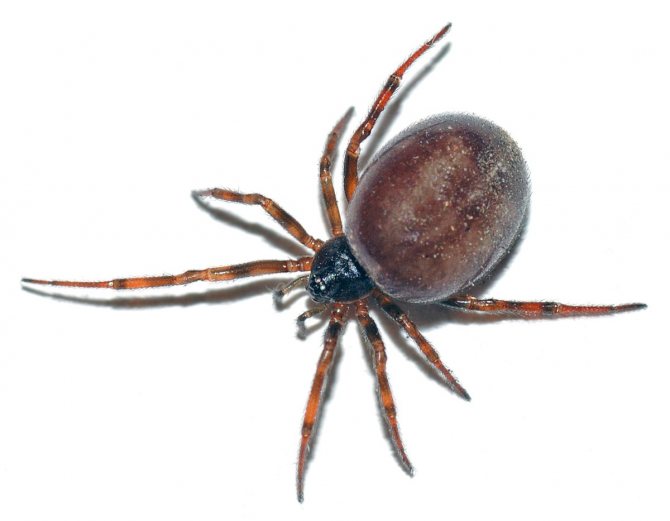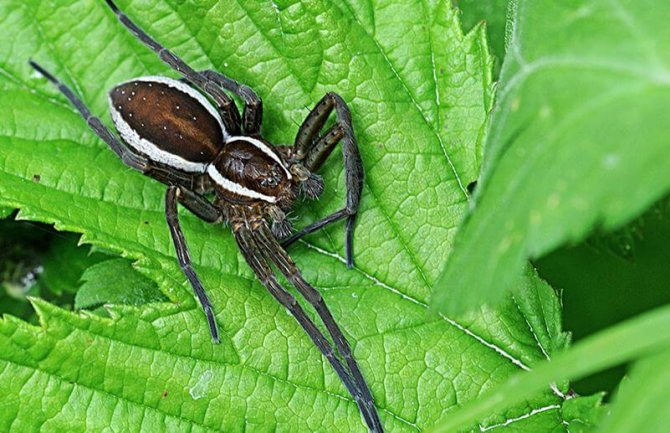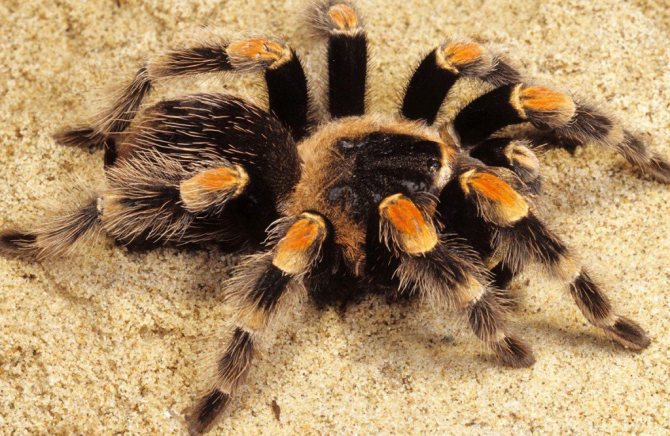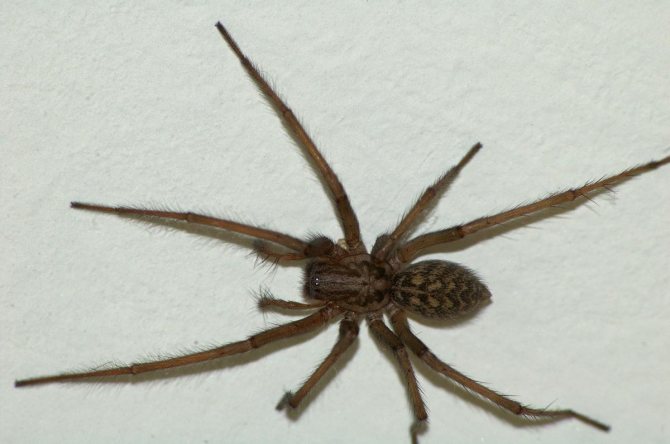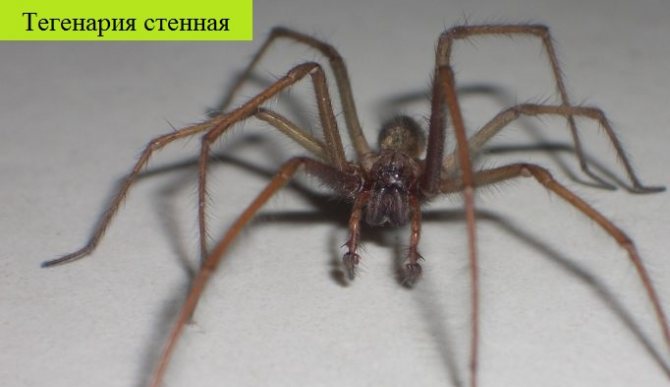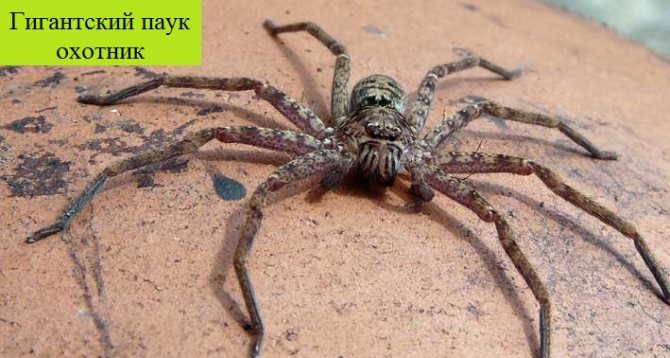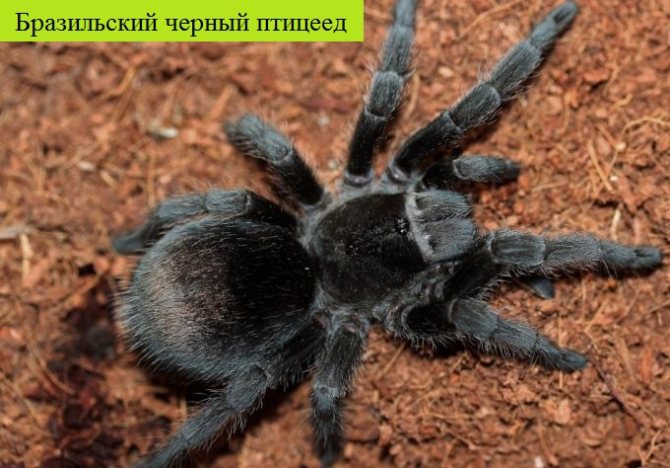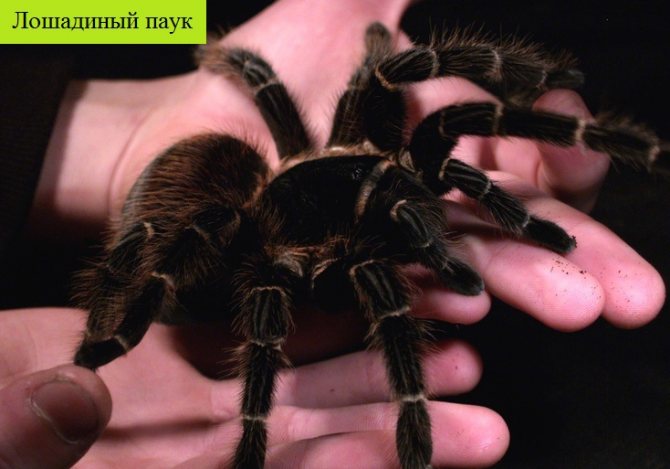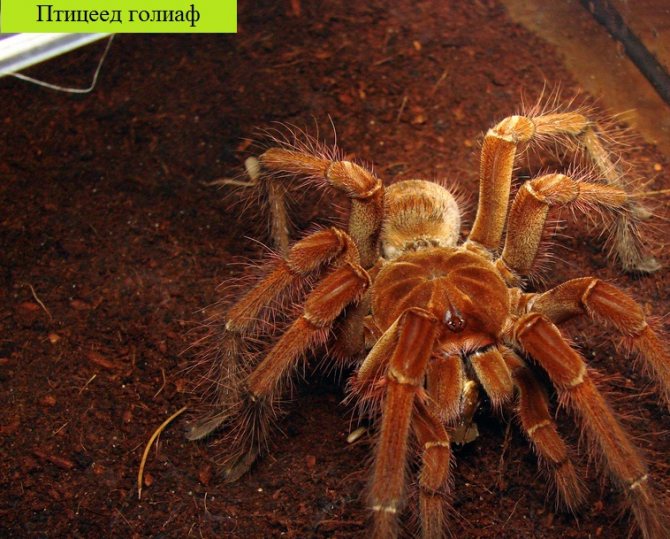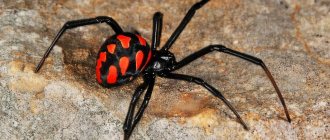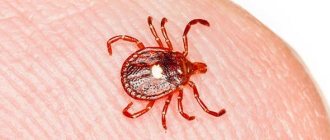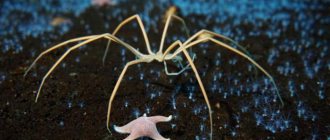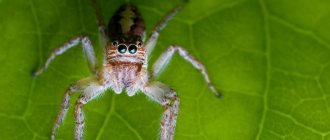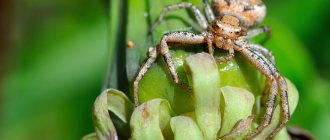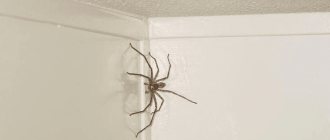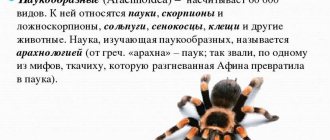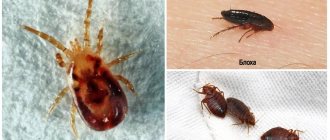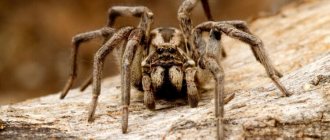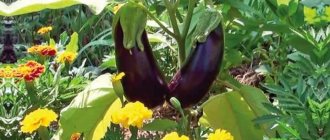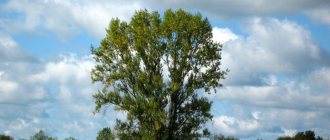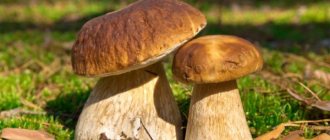Spiders represent a whole squad of predatory animals that consume exclusively living organisms for food. As a rule, spiders catch these insects on their own. At the same time, inanimate objects are not of interest to them.
Interesting to know! Scientists know about more than 42 thousand species of these animals that live on our planet. Although no one knows the exact figure. There are still enough unexplored places on our planet, and new types of small living organisms are discovered almost every day. Plus, spiders are great at camouflaging.
All varieties of arthropods differ in their size, in the size of the paws, in the shape and size of the chelicerae, as well as in the degree of toxicity. The body of the spider can be smooth or covered with bristles of various lengths. In this case, spiders can form a cobweb or live in burrows, but all of them have main signs that allow them to be attributed to the order of arachnids.
Common signs
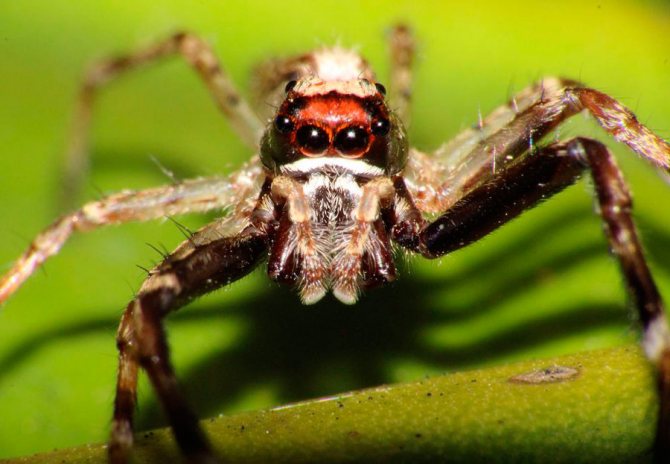
As a rule, an ordinary spider has 6 pairs of limbs, but a person can notice only 4 pairs, since the organs of nutrition and touch are formed from the first 2 of them. The body of the animal has 2 sections - the cephalothorax and abdomen, which are interconnected by a thin bridge. If you carefully examine the spider, you can find that the cephalothorax also has a certain division with the help of a thin groove into the thoracic and head parts. On the chest part, limbs grow, due to which the animal moves and weaves a web.
Interesting fact! Classic spiders always have a spinning organ.
On the head of the spider there are:
- Chelicerae formed by the first pair of limbs.
- Pedipalps formed from the second pair of limbs. They serve for the spider, both as an organ of touch and as a tool for catching and holding insects.
- Eyes.
- Oral apparatus.
Most species have 8 eyes, although the number of eyes depends on the habitat. So, spiders living in caves, where the sun's ray does not enter, do not have eyes as such.
Interesting to know! Oddly enough, but the organs of the extension of the genus of spiders are also located on the pedipalps.
Elephant spider
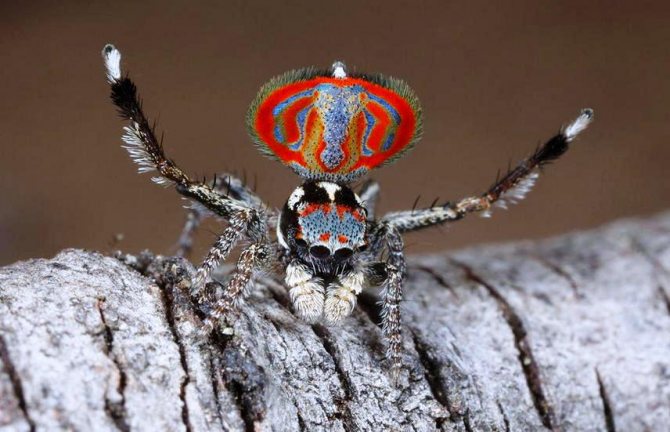

In 2020, a group of scientists from the University of California at Berkeley (USA) discovered several unknown specimens of spiders in Australia.
Among them is a spider found in Sydney by photographer Jurgen Otto, with a pattern on its abdomen that resembles the head of an elephant.
It is a very small spider (Maratus elephans), only about 3-5 millimeters, so you need to use a magnifier or a powerful lens to see its special beauty.
The internal structure of the body of spiders


Spiders differ in that they lack a full-fledged circulatory system, as well as no blood, which is replaced by lymph. There is a heart, but a peculiar one, consisting of 3 or 4 holes, called an awn. Through these holes, lymph enters the region of the heart, after which it is distributed throughout the body in the gaps between the internal organs. After that, the lymph enters the pericardial region of the body and is sent back to the heart. With the help of lymph, the spider receives the necessary portion of oxygen.
The spider's respiratory organ also has a unique structure. The respiratory system consists of plate-shaped lung sacs that resemble books. The air holes are protected by a kind of covers that open at the right time.The respiratory system also includes tracheal tubes that supply oxygen to the internal organs.
Spiders, despite the fact that they are predators, have a well-developed central nervous system, consisting of nerve cells. Nerve formations are located in the cephalothorax, and from them nerve endings are distributed, directed to all organs of the animal. These nodes, the number of which is 2, are the brain of the animal.
It's important to know! The number of nerve cells is very significant, since the volume of the brain is up to 30% of the useful volume of the cephalothorax.
Chilean hermit spider
This arthropod is also one of the ten most dangerous on our planet. Its habitat is the western United States. You can meet a hermit spider in the states of Iowa, Nebraska, as well as in Indiana and Texas. This is one of the largest arthropods of this species. Its body length, including the limbs, often reaches 1.5 inches. Translated from Spanish, the name of this representative of the animal world is "brown spider".
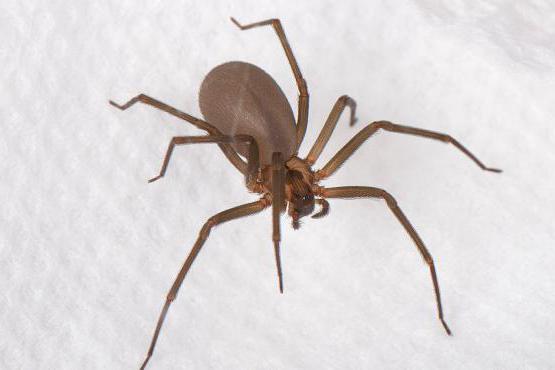

Despite its small size, ranging from 6-20 millimeters, the bite of a Chilean hermit can cause painful death. Toxic substances contained in his saliva cause paralysis of all internal organs, as well as hemolytic anemia and severe renal failure.
How do spiders eat
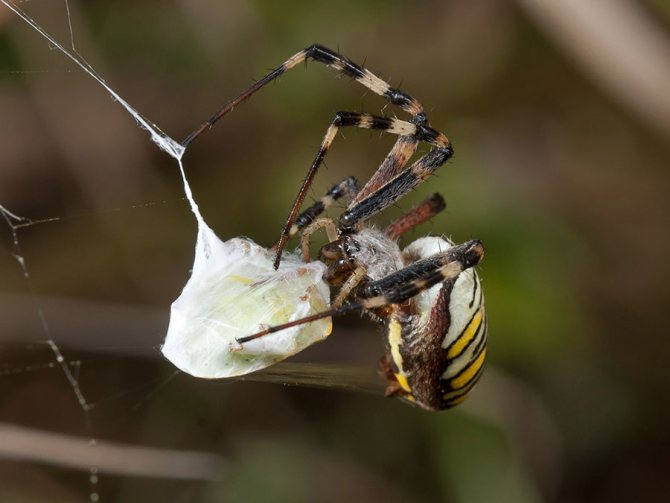

Spiders are obligate predators, since they catch their prey on their own, but they do not have teeth. As a rule, the victim itself falls into the web and in order to eat the prey the spider has to use its poison. The peculiarities of the poison are that it dissolves the flesh of the victim, making a kind of broth out of it. In addition, the poison serves to immobilize the victim. As a rule, all spiders are poisonous, but few are dangerous to humans.
Ogre Face Spider
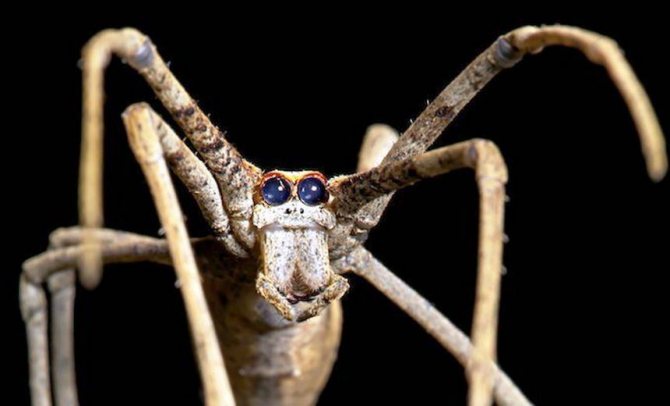

These scary creatures are known as "Ogre Face" spiders precisely because they have large eyes that resemble this mythological creature.
Ogre-faced spiders or gladiator spiders are found in all tropical and subtropical regions of the world, especially in South America, Africa and Oceania.
They are about 2 centimeters long and are mostly nocturnal. To catch their prey, they weave a net between their paws and wait until it is at a sufficient distance to throw the net to catch their prey, like Roman gladiators.
What are spiders
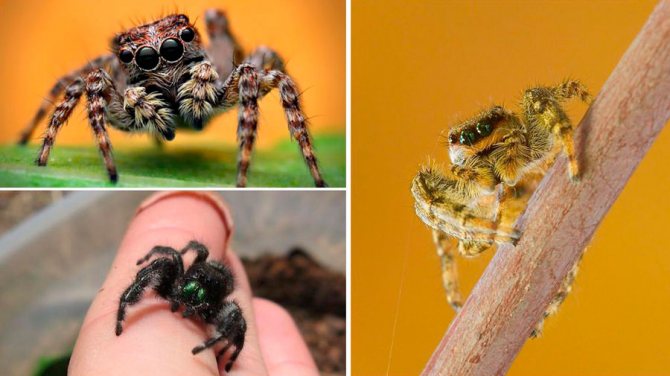

These arthropods are found in any living conditions, so they are found literally everywhere: in the ground, in trees, on bushes, in caves, etc. The only thing is that they cannot fly, although some species easily move in space on their cobwebs. In this case, arthropods can travel great distances.
Spiders are conventionally divided into several groups. For example:
- On those living in burrows.
- Living on the surface of the earth.
- Living under the bushes.
- Inhabiting the trees.
Tree spiders can be easily distinguished by their spider webs, which resemble a target. Spiders that live in burrows use cobwebs to anchor the soil to prevent it from collapsing. Spiders living on the surface of the earth form a web horizontally, using pieces of soil for reliability. Those that live under the bushes weave a cobweb in the form of huts, while they disguise it with the help of branches and earth. Arthropods use all forms of cobweb as a signaling system that signals that living creatures have been trapped.
Interesting to know! The silver spider is the only species that can live in water.
Spider mouse
This most dangerous creature is found in Chile and Australia. This representative of arthropods got its name due to the erroneous opinion of people that spiders, like mice, live underground in burrows they dug.
The size of this poisonous representative of the animal world is very small.Its body length ranges from one to three centimeters.
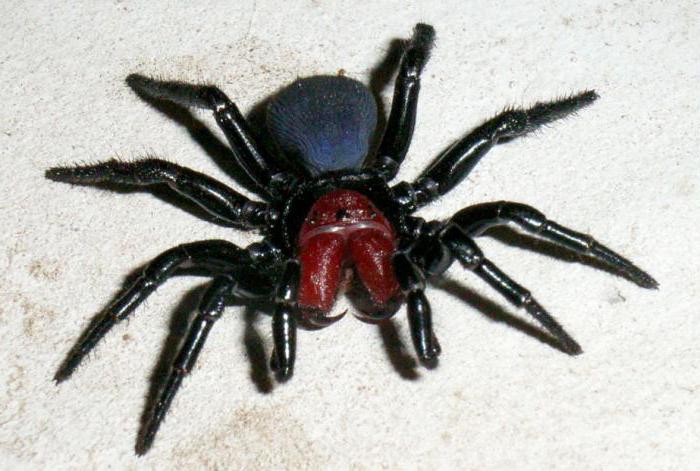

Insects are victims of mouse spiders. They also eat other spiders. In turn, these arthropods feed on scorpions, wasps, millipedes and bandicoots.
The venom of the mouse spider is of protein origin and is considered very dangerous to humans. Fortunately, its individuals are rarely found near human habitation. In addition, the mouse spider prefers to conserve its poison by making so-called dry bites.
Interesting classification
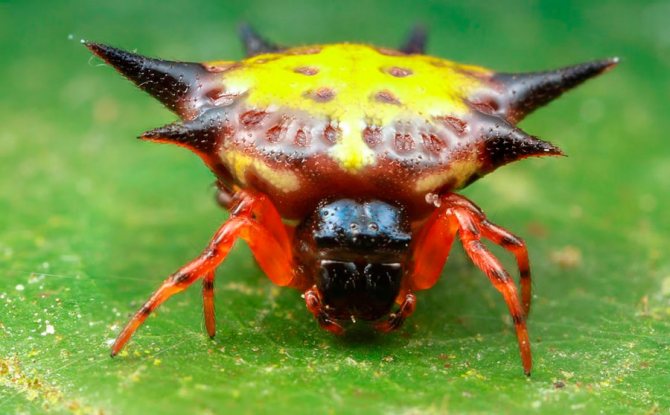

Everyone knows that there are lovers of large tarantula spiders who classify their pets depending on their speed characteristics. For example:
- For Dummies"... These are slow representatives of this species, which many like to shoot on video. They can sit quietly in the palm of a person and move extremely slowly.
- For the "advanced"... These arthropods move fast enough, so they are unlikely to be able to film them.
- For professionals... They move so quickly that it is unlikely that it will be possible to notice in which direction the arthropod disappeared.
If we take into account such speed characteristics, then it is not difficult to assume how many species exist to mankind yet.
Spider "Ladybug"
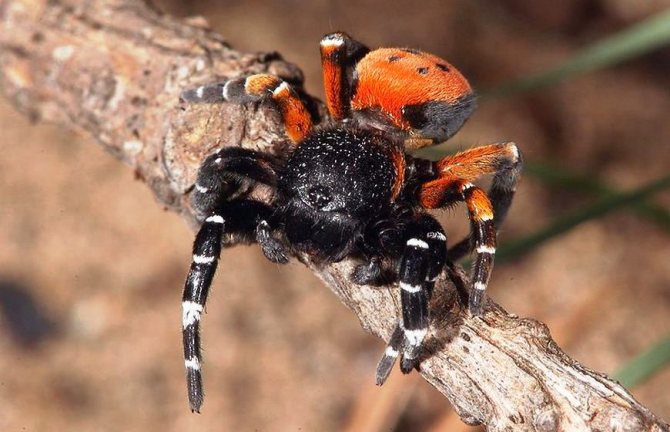

The ladybug (Eresus sandaliatus) is one of the rarest in Europe. It is distributed throughout Northern and Central Europe.
This curious spider has several black dots, four large and two smaller at the back, along with a bright orange or red color that makes them look like ladybugs.
The only specimens that present this curious feature are males. Females are all pitch black, just like males when they are still very young.
Deadly poisonous spiders
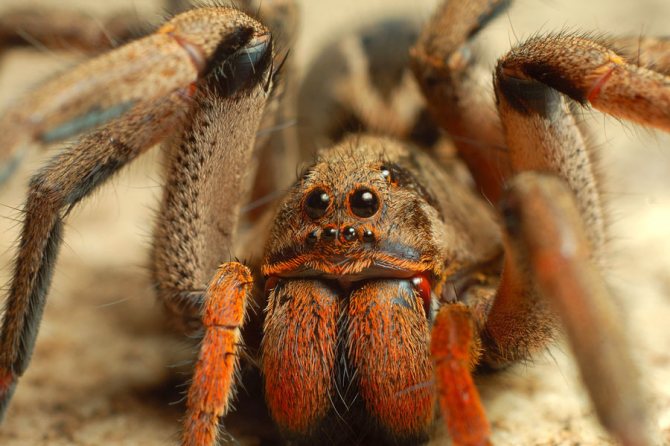

As a rule, the majority of spider species are not dangerous to humans. The only problem is the presence of cobwebs in the most inappropriate places for humans. It should be noted that there are very poisonous species, the bites of which can be fatal to humans.
The deadly ones include:
- Black widow, as well as karakurt.
- Brazilian runner spiders.
- A brown recluse spider.
Black widows received such an interesting name due to the fact that after mating, if the male does not have time to leave, the female simply eats him. This dangerous species is spread over almost all continents. They hunt their prey according to the lasso principle, using their web for this. The most famous American black widow in this regard, and as for the rest of this genus, they do not pose a serious danger.
North American Black Widow
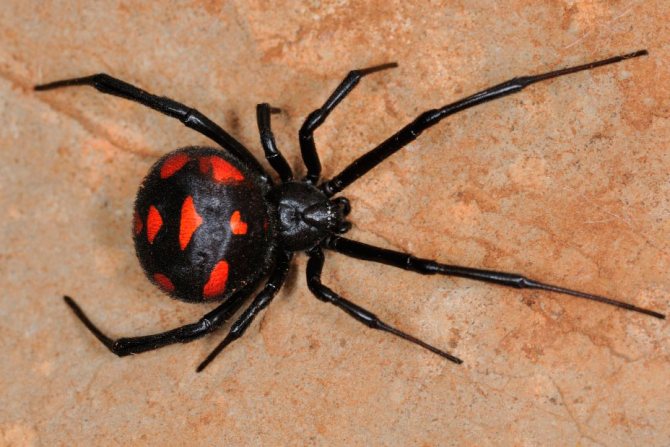

On the North American continent, you can find up to 5 species of black widows, which are distinguished by a black body color with the presence of red spots on the abdomen.
It's important to know! Not all representatives of black widows are distinguished by their black body color.
The main distinguishing feature of this kind of spiders is the presence of long legs, as evidenced by photographs of these dangerous animals. A spider bite is somewhat similar to a pin prick, but after 30 minutes, muscle cramps appear that spread throughout the body. When the serum was not yet invented, up to 5% of the victims died from their bites.
South American black widows
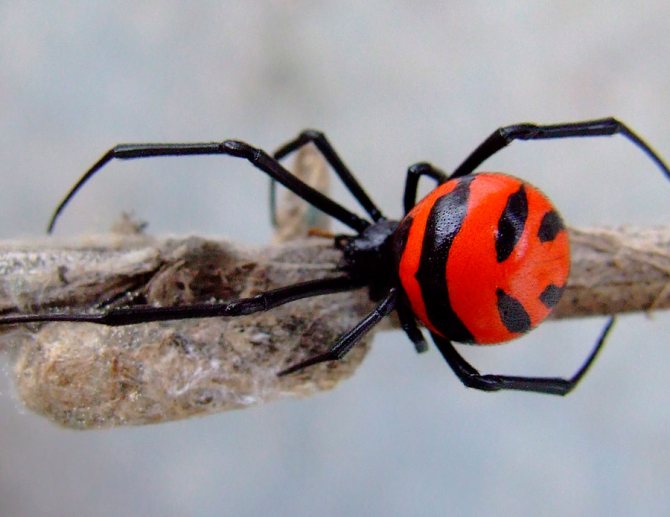

Representatives of this genus living in South and Central America have been studied very little. It is known that up to 8 species live in these places. This is due to the fact that spiders inhabit hard-to-reach places that are not so easy to reach.
Karakurt
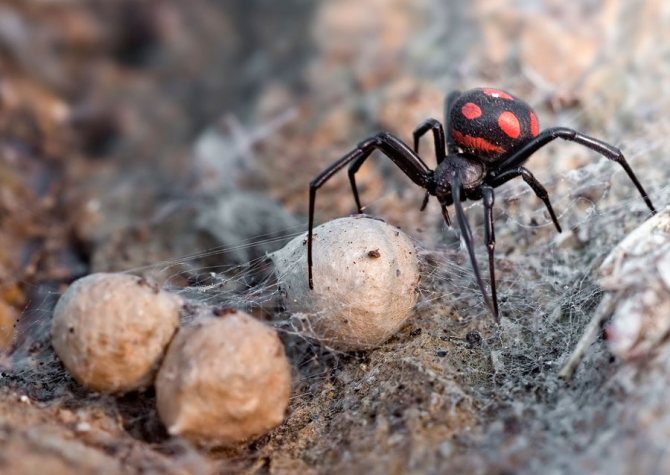

These poisonous and dangerous arthropods live in Eurasia and Africa. Here there are up to 18 varieties of them, differing in varying degrees of danger. These are the same black widows, but who received the name karakurt here.Black karakurt prefers to live in the southern regions of the continent, including the Crimea and the Mediterranean. Due to the fact that global warming processes are observed on the planet, black karakurt was found in colder regions. As a rule, the ideal living conditions for this arthropod are high above zero temperatures.
The image and name of the spiders do not correspond to reality, since these types of karakurt are distinguished by the presence of large red spots on the back. The coloration of spiders can be different due to the fact that Eurasian species often interbreed with each other. As a result, black karakurt can have a pure black color.
Interesting fact! There is also a white karakurt in nature. This type of karakurt is not so poisonous, but children and allergy sufferers can suffer from their bites. They live in the same conditions as black karakurt.
Oceania and Australia
The Australian black widow is considered one of the most venomous arthropods.
Latrodectus geometricus


The black widow of this species is common on almost all continents. When viewed from the back, the spider is brown in color, and the red spot is located on the lower abdomen. This black widow has yellow-brown paws, and black stripes can be seen on their curves. Of all the representatives of this genus, it is considered the least dangerous creature and is dangerous only for children and the elderly.
Brazilian wandering spider


More recently, it was believed that black widows are the most dangerous species of spiders, but by 2010 it became known about the most dangerous species - the Brazilian soldier spider. The genus of these most dangerous arthropods has about 8 species. Their habitat is limited to the tropics of South and Central America. The most interesting thing is that spiders of this species erect trapping webs, and hunt in an active way.
Interesting fact! The last species of these arthropods was discovered only in 2001.
After being bitten by a soldier spider, paralysis and suffocation occur. As a result of the ingress of poison into the blood, in 85 cases out of 100, complete cardiac arrest is observed.
Hermit spider


This is one of the species that represents the North American continent. The body color can be either brown or dark yellow, or gray. The size of the legs can be in the range from 6 to 20 mm. The hermit spider has only 6 eyes, compared to the bulk of the species. This can be seen in the photo if you enlarge the image.
In the daytime, he prefers to be in shelter, and goes hunting in the dark. Despite the fact that he does not hunt with the help of a web, he nevertheless weaves a web, but uses it as a shelter. He can easily be found in a person's home, so he can easily climb into bed. If you press him down, he will certainly bite.
Over time, a necrotic ulcer forms at the site of the bite, which can heal for several years. There are also deaths when a child or a person with weak immunity becomes a victim of a bite.
Sydney funnel spider
This representative of arthropods is small to medium in size. He was rightfully included in the top lines of the list, from which the top of the most dangerous spiders on our planet is compiled. The fact is that his bite can cause death.
The size of the female Sydney funnel web spider ranges from 1.5 to 3 cm. Males are usually one centimeter smaller. The body color of these spiders is beige-brown and sometimes black. Two dark longitudinal stripes located on the back help to distinguish these arthropods from their relatives.
The habitat of the described spider is Australia. Most often it can be found in New South Wales. This representative of the animal world loves to settle in the forests, as well as in the area developed by people.Funnel spiders often roam backyards and can occasionally enter pools. It is undesirable for people to encounter these arthropods, since with a possible threat they become aggressive.
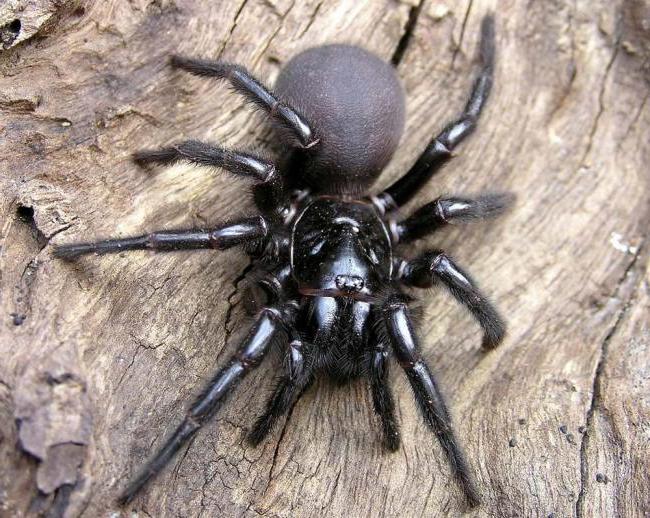

The Sydney funnel web spider produces a strong venom. Moreover, the toxic substance is produced by arthropods in large quantities. The danger of the spider lies in its long chelicerae. These are a kind of "fangs" in which, near the very point, there are channels that excrete the poison. It is worth saying that the Sydney spider's chelicerae are larger than those possessed by the brown snake, which is also very dangerous to humans.
The poison of the Australian arthropod contains a component that acts on the nervous system of the victim. Once in human blood, it changes the functioning of all systems and organs. Even a lethal outcome is possible with a bite of males. In 1981, scientists developed an antidote to eliminate the danger of death to humans. Since then, no deaths have been reported from the bite of the funnel-shaped Sydney spider.
Spiders are moderately venomous
As a rule, the bites of these arthropods do not cause serious concern, but as a result of the bites, swelling of the limbs, as well as severe pain, appear. These spiders include:
- Banana spiders
- Tarantulov.
- Saku spider.
- Wasp spider.
The result of a bite from these arthropods is minor irritation, but too much poison can cause swelling of the limb.
Banana spider


These species have several names, depending on the habitat conditions. These are spiders that form extensive webs and call them large tree orb-web spiders. Depending on the habitat, they are called:
- Banana spiders.
- Large tree spiders.
- Goldweavers.
They grow in length up to 4 cm and have a paw span of up to 12 cm. They are not dangerous for people. In the event of a bite, the place blisters and turns red, and all this is accompanied by a strong burning sensation. As a rule, within a day, the negative effects of the bite disappear.
Tarantulas
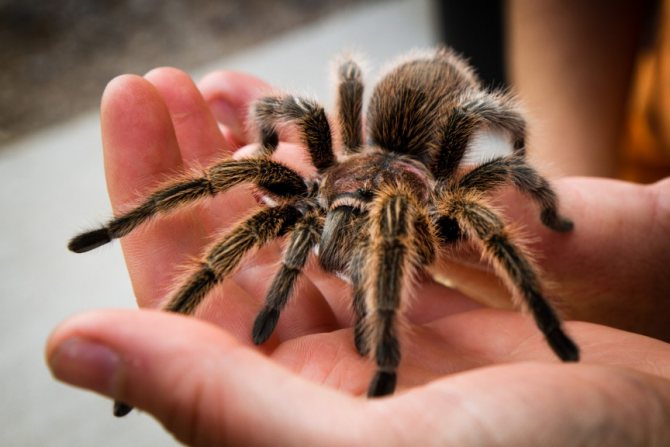

Tarantulas are also called wolf spiders, since they are representatives of this family. The South Russian species and the Apulian tarantula are of particular interest. They differ primarily in their solid size, while trapping cobwebs are not formed. They hunt at night, attacking various invertebrates and other spiders. They live in earthen holes, up to 0.6 meters deep and up to 1.5 cm in diameter. Animals are distinguished by a gray color of their body, while the abdomen is covered with wool. The paws of an animal are of medium size.
Tarantulas prefer to live in the hot regions of the Eurasian continent, in dry steppes. They are especially poisonous in the spring when they have a lot of unspent poison. At the same time, in order for the tarantula to bite, you need to strongly desire. To anger an animal, you will have to pull it out of the hole, and then take it with your bare hands. It should also be remembered that tarantulas are capable of vertical leaps if they are in danger. But this does not mean that he will pounce on a person, since at the first danger he will try to hide.
Interesting fact! In some countries, large tarantulas are called tarantulas.
Spider sak


This animal has another name - yellow heiracantium. More recently, he was a representative of exclusively southern regions, but as a result of global warming, he can be found in the middle zone of our country. Its widespread distribution was also facilitated by the spider's indifference to the smell of oil. In this regard, he is a frequent guest of the car engine. It is located between the engine mechanisms, and closes the ventilation system with cobwebs.
The spider does not differ in impressive size, since it is only 1.5 cm in length maximum. The span of the paws is about 2.5 cm. The body is colored yellow-brown. A characteristic difference is massive chelicerae with a long extension, in the form of needles.They help the spider to hunt at night and are very active. In the photo you can see what this spider looks like.
In the case of a bite of such an animal, soft tissue necrosis develops. In addition, the bite may be accompanied by nausea, severe headache, and high fever. The bite site becomes red and inflamed.
Argiope or wasp spider


Represents the family of orb-web spiders. Due to the unique body painting, which resembles the body painting of a wasp, the spider was named that way - the wasp spider. There are several species in nature. Their habitat is limited to 52 degrees north latitude.
Interesting to know! The wasp spider refers to a species that is able to fly a considerable distance on its web.
It hunts due to the fact that it weaves round-shaped trapping nets. He does this at dusk. The main diet consists of flying insects. Biting is very painful, but not dangerous. Typically, the site of the bite becomes inflamed.
Dangerous species
Dangerous spiders in Russia are much less common than harmless species. They release strong toxic types of substances at the time of the bite, which can lead to paralysis and even death. You need to know such spiders, as they say, by sight and beware of them.
In case of a collision with the individuals described below, you must immediately contact the nearest medical institution in order to avoid unpleasant consequences.
Poisonous spiders:
- crosses;
- hirakantida;
- karakurt;
- South Russian tarantula.
Let's consider them in more detail.
Cross fittings
Scientifically they are called Araneus... The main diet of the cross consists of small insects: butterflies, flies, mosquitoes and others. The spider weaves an extensive web into a very fine mesh. The victim caught in it is immediately immobilized by the poison and entangled. By means of the introduced enzymes, which in their properties resemble acid, the prey passes into a semi-liquid state.
After a while, the predator starts the meal, eating the resulting gruel. If the catch is rich, then the cross leaves insects for later, attaching them to the edge of the cobweb. In the absence of prey, the spider increases the area of the network, or moves to another place.
The dimensions of the crosspiece can in no way be called large. The abdomen of the male does not exceed 11 mm, and that of the female is 25 mm. The spider can be found throughout the territory of the Russian Federation. The highest density was recorded in thickets of spruce and pine forests. With rare exceptions, the predator can be found in fields, swamps and fruit trees.
Distinguishing the cross from other representatives of arthropods is not so difficult. On its back there is a pronounced pattern resembling a cross. The body of the spider is covered with a waxy layer, which helps to retain moisture on hot summer days.
4 paired eyes can be seen on the head of the predator. The chest is protected by a strong chitinous cover. The dorsum of the abdomen includes several pairs of arachnoid warts, each of which has a mass of small holes. The color saturation largely depends on the ambient light. As a rule, it is a light gray color, sometimes with a reddish tint.
The erythrocytes of horses, dogs and sheep are resistant to spider venom, while it can cause serious harm to humans, especially people with weak immune systems. Fatal outcomes were not recorded, but in advanced cases, soft tissue necrosis develops at the site of the bite. The latter is quite painful and can cause a fever and anaphylactic shock in allergy sufferers.
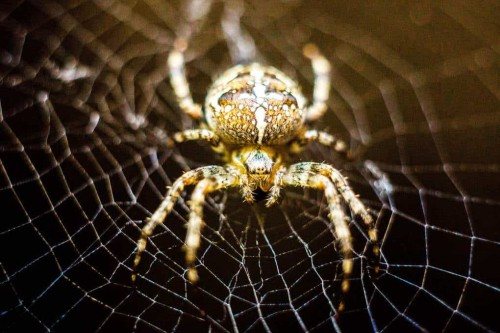

Hirakantis
The common name of the species is Cheiracanthium... The habitat of the spider is the middle zone of Russia. The predator prefers to hunt in grassy thickets and bushes. Representatives of this species are distinguished by a wandering lifestyle, that is, they do not weave webs.
Individuals are most active in the dark. For hunting, the spider uses a sand or earthen rampart slightly burrowing in it.The victim, touching the hirakantida, immediately turns out to be bitten and paralyzed, after which the predator calmly eats.
The spider's diet consists primarily of caterpillars, ticks, grasshoppers and other inhabitants of vast meadows and fields. The predator tries to avoid contact with wasps and large red ants. The latter pose a serious danger to him.
The size of the spider's body does not exceed 1.5 cm in females and 0.5 cm in males. The abdomen and legs are colored light brown, less often greenish or yellow. The dorsal part of the body is slightly pointed, and the front legs are noticeably longer than the rest of the limbs.
Spider venom causes severe pain and redness on human skin. After a while, the rash begins to spread, vomiting appears. If the antidote is not administered, the lymph nodes begin to swell. But it’s not that bad. Without urgent medical attention, cramps and severe breathing problems begin. After the introduction of the antidote, the symptoms disappear after a couple of days.
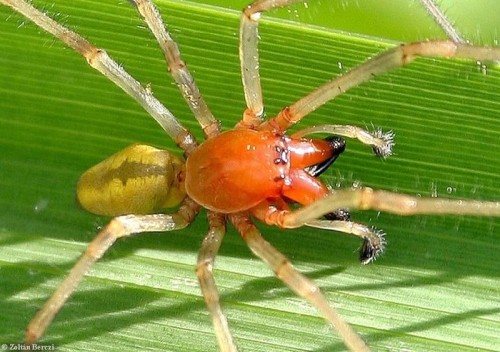

Karakurt
Scientific name - Latrodectus tredecimguttatus... Representatives of this species are most often called the black widow. Varieties of karakurt live mainly in the Caucasus and the Urals. Also, rare cases of the appearance of karakurt were recorded in the Volgograd and Astrakhan regions. Single specimens were observed in the forests of the Moscow region.
The spider avoids all contact with humans, therefore it does not settle in residential buildings, and even more so it does not approach multi-storey buildings. The predator prefers steppe regions with hot and dry climates. The main enemies of karakurt are wasps and hedgehogs.
The spider lives in small holes. Near a person, he finds refuge in landfills and cluttered summer cottages. Often uses ready-made rodent passages, drainage pipes and other technical holes of small diameter. The predator protects the exit with a dense net.
Karakurt looks spectacular and matches its nickname: a body black as night, diluted with bright red spots on the abdomen. The length of the female body reaches 2 cm, while the males are half as long. The older the predator, the darker its main color. Red spots become less visible with age.
The poison is most dangerous in females after 5-6 molting. The spider will attack large animals and humans only in case of aggression from the latter. The bite of karakurt is quite painful. After contact with a black widow, sharp pains occur throughout the body, severe shortness of breath appears and the heartbeat becomes more frequent.
Large portions of the poison cause depression, dizziness, delirium and confusion. People with reduced immunity can experience serious allergic reactions up to anaphylactic shock. After being bitten by a black widow, you must immediately seek help from a specialist.
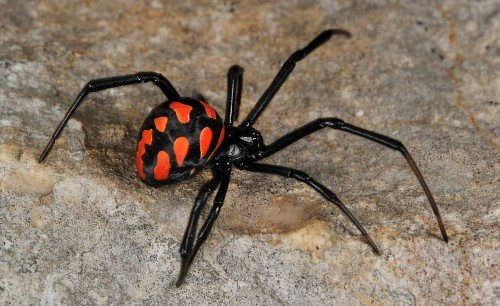

South Russian tarantula
Another rather dangerous species is Lycosa singoriensis... The South Russian tarantula is light gray in color and has a body length of up to 3 cm. The spider's habitat is steppe and semi-desert with a predominantly dry climate.
The predator uses narrow burrows 40-50 cm deep as a dwelling. The exit is reliably protected by a dense net. The Russian tarantula hunts right from the hole, looking for the victim in the shadow. When the prey passes by, the spider quickly jumps towards it and injects its poison. Then he braids with cobwebs, drags him into the house or eats him on the spot if he is very hungry.
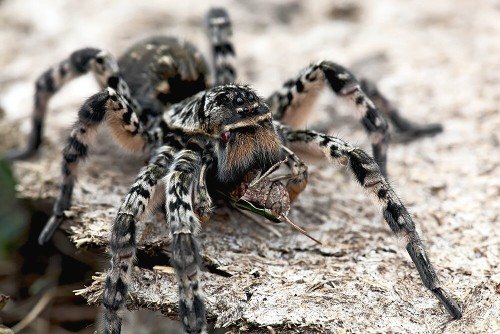

The predator is able to jump more than 15 cm in height, which makes it even more dangerous for animals and humans as well. The spider never attacks without visible aggression from the intruder. The bite is not as painful as that of the same black widow, but without an ambulance and serum, a strong allergic reaction can develop: lymph nodes swell, nausea, fever appear, and in advanced cases, death.
South Russian tarantulas survive the cold season quite easily, going deep into their burrow and clogging the inlet with earth.If a spider has chosen a warm wintering place for itself near human habitation, then it does not hibernate, continuing to hunt occasionally. In the absence of suspended animation, the life span of the predator is noticeably reduced from 2 years to 1.5 or even one year.
Safe spiders
This group of spiders should include those representatives who are either unable to bite through human skin, or their venom is too weak to harm. Spiders of this class include:
- Tarantula spiders.
- Cross spiders.
- Haymaker spider.
- Brownie spider.
- Horse spiders.
Spiders are of no interest to spiders, since their purpose is completely different - to live in nature so that no one touches them.
Tarantula spiders


These animals represent a group of the largest spiders on the planet, of which the goliath spider is considered the champion. Its size is simply amazing - about 10 cm, and its paw span is about 28 cm. These spiders are also distinguished by the fact that their body is covered with thick wool of red-brown shades. For a person, this monster is not dangerous, but its falling bristles can lead to various allergic reactions.
Spiders cross


They are considered relatively large representatives of their genus. You can easily distinguish them from other types of spiders by the characteristic pattern in the form of a cross located on the back of the animal. It is a typical representative of gardens, parks, forests and other green spaces. He uses a cobweb as a tool for catching food. The spider itself may be in a shelter of old leaves.
Spider bites are not dangerous even for children, but he can let the child know so that he does not touch him.
Haymaker spider


This living creature with long legs constantly annoys a person by constantly weaving a web, which has to be constantly removed. He prefers to live in houses or apartments, but he can also be found in other outbuildings. Not dangerous to humans.
Interesting to know! Haymakers weave a web chaotically in all hard-to-reach places with great zeal, after which they have to regularly harvest the fruits of their zeal.
House spider


Represents the funnel spider family. The family got its name thanks to the weaving of funnel-shaped spider webs. It can often be found in a person's home, as well as in other places. The female grows in length up to 7 - 12 mm, and the male is more modest in size - only 6 to 9 mm. The body of the animal has a brown tint. In relation to people, he does not show aggression, but if you disturb him and stick your finger into the shelter, then he will surely bite. At the same time, there will be no negative consequences from the bite.
Jumping spiders


They represent one of the most numerous families. They are found almost everywhere, except for Greenland. They differ in that they can jump, while they go hunting mainly during the day. The horses are also distinguished by the unique structure of their body, namely, by the presence of a kind of hydraulic system. Thanks to these capabilities, which allow regulating the pressure in the circulatory system, spiders can perform jumps incommensurate with their own parameters.
Interesting fact! In the family of horses, there is one species that is considered a vegetarian. This species inhabits Central America, and feeds on trees of a certain species. Despite this, in conditions of a lack of moisture, they can eat their relatives.
Peacock spider
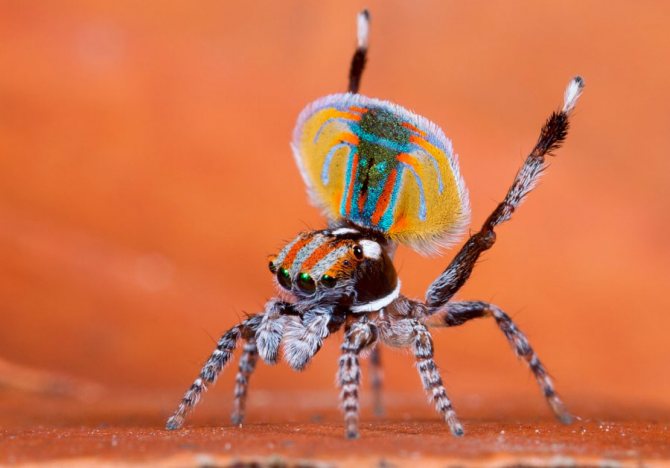

A unique species of spiders representing the racehorse genus. This small living creature is endemic to Australia, therefore it is not found anywhere else on the planet. This unusual creature got its name due to the fact that it practically copies the behavior of the most beautiful bird. At the same time, the male also has brighter colors than the female. During mating games, the male spreads his tail, and also uses the side shields located on the abdomen. Together with the hind legs, he lifts them up.If the female is not present, then the males wrap the shields around themselves.
Spider tramp
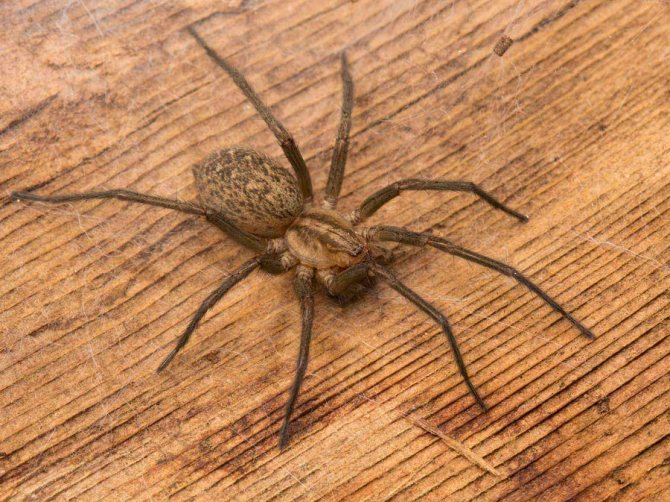

They do not weave hunting webs, but hunt various insects from an ambush. By the nature of the hunt and the structure of the eyes, they can be compared with wolf spiders. The female nevertheless weaves a web, but for completely different purposes - forming a cocoon, she lays eggs in it. At the same time, she carries a cocoon behind her back.
Hunter limb
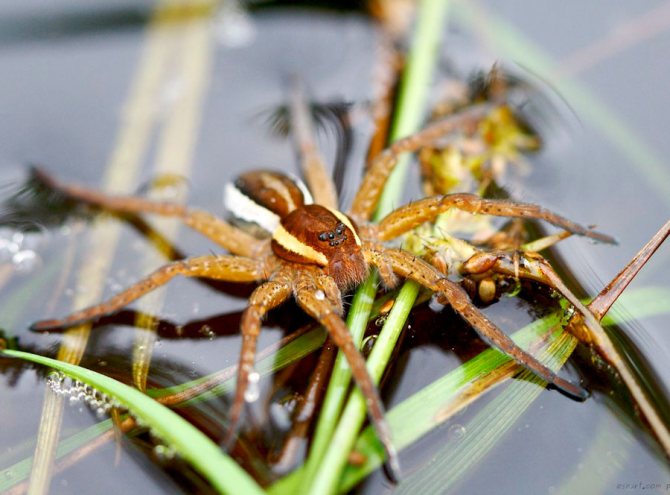

It is a family of hunting spiders and can grow up to 2 cm in length. It has a yellow-brown body color, although, depending on the habitat conditions, the color may have darker tones. A characteristic feature is the presence of a white stripe on both sides of his body. Prefers to settle on the banks of various water bodies located in the temperate zone of Eurasia. The species is quite unique, as individuals can move through the water and even dive if necessary. It has another name - the angler spider, as it can hunt fish fry.
Spider green
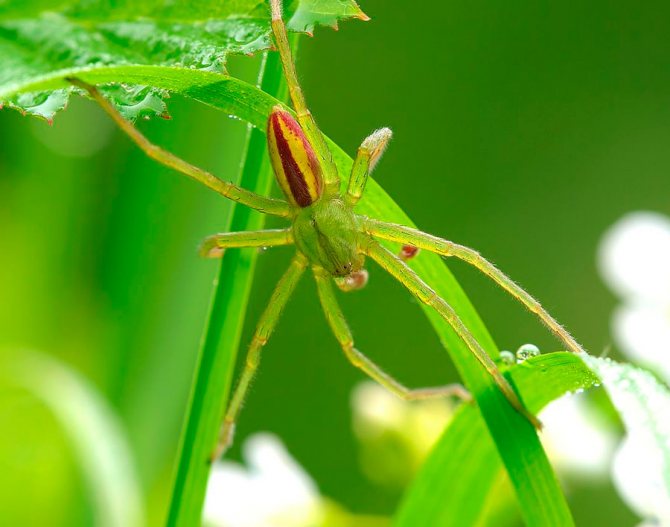

In fact, this species does not exist in nature. Various spiders belonging to a particular genus can have a similar color. For example, green can be:
- Jumping spiders.
- Hunter spiders.
- Lynx spiders.
To find out how dangerous a green spider is, you first have to decide on its appearance.
Crab spider
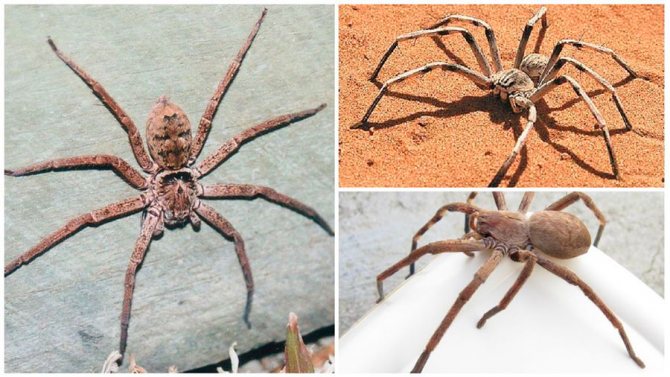

This type of spider also does not exist, but some of the species can move sideways, like crabs. For example:
- Neocribellatae species.
- Thomisidae species.
- Philodromidae species.
It's important to know! These three types of spiders are not considered dangerous for humans.
Brazilian spider
This representative of arthropods is the most dangerous on our planet. For this reason, he was even entered into the Guinness Book of Records. With him we start the top 10 most dangerous spiders in the world.
Where does he live? The Brazilian wandering spider can be seen in the American tropics or subtropics. At the same time, two groups of these representatives of the animal world are distinguished. The first of them includes jumping spiders. So they are called according to the way the victim is pursued. These spiders catch up with their prey using abrupt jumps.
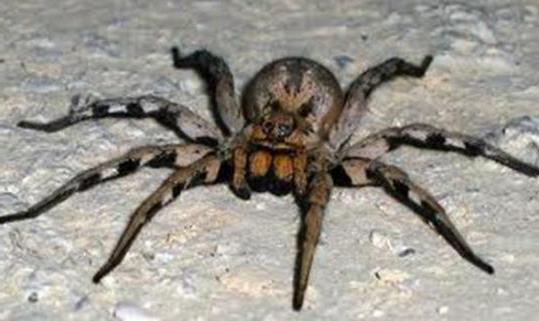

The second group includes running arthropods. These Brazilian spiders chase their prey very quickly. Representatives of the second group go hunting at night. During daylight hours, they hide under stones or in places where they cannot be seen. Such spiders can live both on the ground and in trees.
Why are these arthropods called wandering? The fact is that the Brazilian spider does not weave a cobweb like its relatives. He constantly changes his place of residence, moving in search of food.
The most dangerous spider on our planet brings a lot of trouble to the inhabitants of South America. This poisonous creature invades their homes. The Brazilian wanderer is often found in food boxes or wardrobes.
What are the characteristics of the most dangerous spider on our planet? It is distinguished by its small size. In length, the Brazilian wanderer can grow up to 10 cm.However, the small size does not prevent these arthropods from being the most dangerous spiders in the world.
They are excellent hunters, posing a great danger to humans. It is worth saying that the bite of this arthropod leads to suffocation, which is often fatal. The good news is that there is an antidote to save human life, which should only be introduced in time.


Of course, healthy adults do not have to worry about their lives after being bitten by the most dangerous spider on our planet. They can only have a strong allergic reaction to its poison. But the toxins that have entered the body of a child or a sick person can lead to the most sad result.
What does the most dangerous spider of our planet prefer to eat? Bananas are his favorite delicacy. That is why Brazilian wanderers prefer to climb into the boxes in which these fragrant fruits are stored.For such love this representative of arthropods is often called the "banana spider". However, the main food for him, of course, is not fruits at all. The most dangerous spiders in the world hunt insects.
Even relatives of other species become their victims. In addition, Brazilian wanderers attack birds and lizards, which are much larger in size.
The most dangerous spiders in the world do not attack people. They bite a person only for their own protection.
Other arachnids
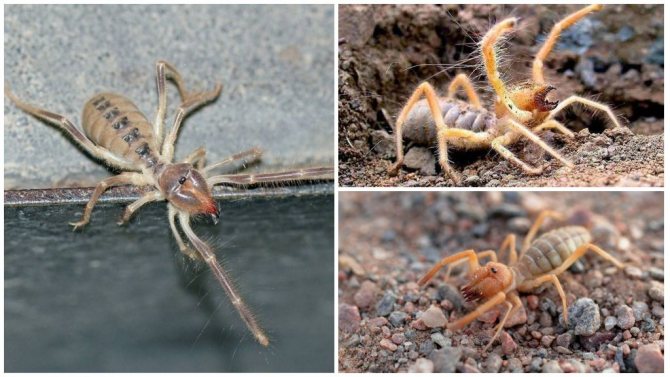

Large arthropods live in Central Asia and Africa, which, unknowingly, are confused with spiders. In fact, these are solpugs or, as they are also called, camel spiders. Unlike spiders, these living things do not have poison glands and glands for creating a web, but they are armed with teeth.
Spiders in many people cause a feeling of fear, but this is rather from ignorance. In fact, these are rather harmless living beings.
Black Widow
The top 10 most dangerous spiders in the world are continued by this small representative of arthropods. Its body length is only 1.5-2 centimeters. And although the females of these representatives of arthropods are twice as large as males, they are also quite difficult to distinguish in natural conditions. Nevertheless, these are the most dangerous spiders, almost at the top of the corresponding rating.
The Black Widow is in constant "mourning". Only mature adults have red hourglass marks on their abdomen. Young spiders are light in color. Their body is sometimes white or yellowish white. The color only gets darker with age. The body of these spiders acquires black color only by the second or third month of life.
This most dangerous spider got its "mourning" name not by chance. The females of this arthropod are cannibalistic towards males.
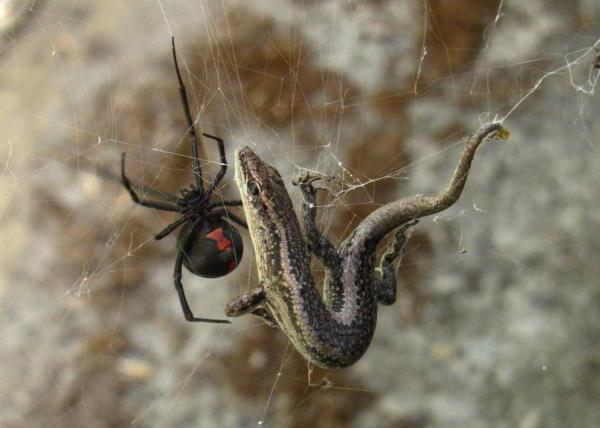

The place of residence of these spiders, as a rule, is the Central Asian deserts and steppes. They are less common in the Caucasus, as well as in the Crimea.
The Black Widow, ranked third out of the 10 most dangerous spiders, prefers to hunt in recesses under stones, placing her snares at a low height from the ground. It also watches over the victims in crevices and various holes, above squat plants and even in the thick of grape vines.
Representatives of these spiders go hunting at night. During the day, they prefer to hide in their hiding places. As a rule, insects serve as food for the black widow. However, these spiders are not averse to dine with woodlice and their own relatives.
A black widow bite is dangerous to humans. This is especially true for the elderly and children. The poison, spreading through the body, causes severe muscle spasms. Also, after the bite of a black widow spider, weakness and headache, shortness of breath and increased salivation, vomiting, anxiety and tachycardia appear. You can neutralize the poison by burning the bite site with a match. To eliminate the likelihood of an allergic reaction, it is also advisable to take the victim to a hospital.
Habitat
Arachnids exist where conditions permit, i.e. absolutely in every corner of the planet, with the exception of areas with severe frosts and regions that are constantly covered with a large layer of ice. Basically, arthropods are considered terrestrial inhabitants, but there are spiders that live in dug holes or nests, leading an active lifestyle only at night.
Tarantulas and other mighalamorphic species live on equatorial trees and bushes. Drought-resistant rocks settle in rock crevices, burrows and other shelters located at soil level. Excavators prefer to settle in groups, in separate burrows, the depth of which can be up to 50 cm. Some species cover their houses with special shutters, which they make of silk, soil or grass.
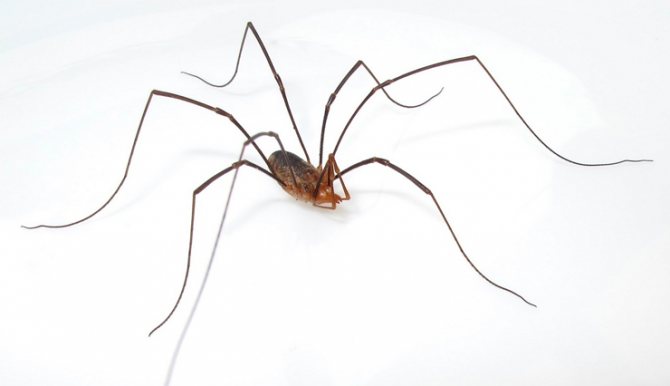

Hay spiders can often be found in damp and dark places.
The so-called hay spiders prefer to live in dark and humid places, such as caves, uninhabited destroyed buildings, basements, as well as in holes that were abandoned by various animals. Centipedes settle in living quarters, on the windows on the south side, hanging with their heads down.
Jumping spiders are able to survive almost everywhere, with the exception of icy places: in the desert, in forest-steppes, in the mountains, on stone and brick buildings.
Karakurt mainly lives on the territory of wormwood wastelands, where spiders are often trampled into the soil by herds of domestic animals. They can also be found on the rocky slopes of ravines, on the coast of artificial canals.
Spiders in Russia
About 1000 different species live on the territory of Russia. Among them are safe and poisonous individuals. Some live indoors with people, while others live exclusively in the wild. Scientists continue to study and find out what spiders are on the territory of Russia.
Brownies and spider-knitter
House spiders and knitting spiders have become some of the common species. The former feed on insects and live next to humans. They are small in size (12 mm), dark yellow or brown in color.
Knitting spiders 10 mm in size. They live exclusively in nature. Their body is elongated. Round nets with large meshes are weaved. They feed on long-legged mosquitoes. Both types are completely safe for humans.
Hirakantis
The individual lives in dense grass and thickets. Doesn't weave webs. She hunts at night for caterpillars, moths, aphids, grasshoppers, etc. It strikes prey with one jump.
Hirakantida are yellow or light brown in color. Body length - 5-15 mm. The forelimbs are 2 times longer than the hind ones. Hirakantida venom is extremely toxic. After the bite, there is severe pain, swelling, swelling and impaired mobility.
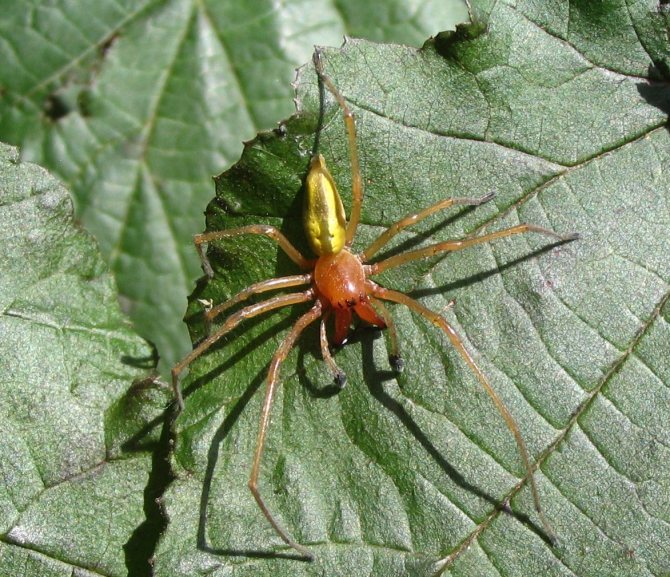

South Russian tarantula
Inhabits the desert, semi-desert and steppe zone, prefers a dry climate. The size of its brown-rufous body reaches 30 mm. Most of the time it sits in a hole, if a potential victim appears next to it, the spider jumps out and catches it.
The bite of a tarantula is painful, comparable to that of a hornet. The poison provokes swelling and yellowing of the bite site. No lethal outcomes were found. Life expectancy is about 2 years.
Feature and Description
The general description of spiders may differ depending on the specific species. Usually, the body of this arthropod consists of only two main parts:
- Abdomen. The main breathing holes are located here, the surface is covered with fine wool.
- Cephalothorax. The surface of the cephalothorax is a chitin shell. There are 8 articulated long legs. In addition, there are two legs on the cephalothorax. They are used so that mature individuals can mate. Also on the cephalothorax are two short limbs with chelicerae, which are poisonous hooks. They are considered part of the mouth apparatus. Depending on the variety, the number of eyes in individuals can vary from 2 to 8 pieces.
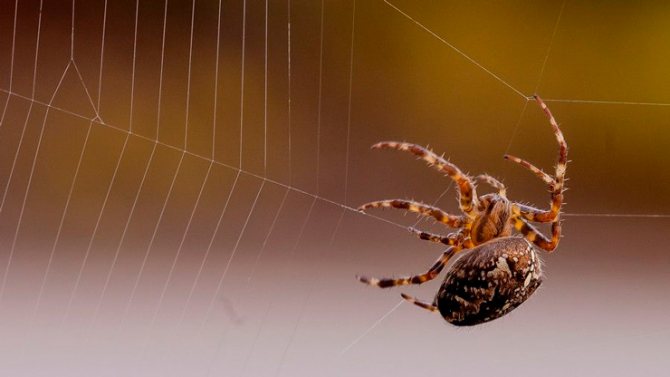

Contrary to popular belief, spiders are arthropods, not insects.
As for the size of arthropods, they can also be different - from 0.4 mm to 10 cm. These parameters apply only to the cephalothorax. The paw span can be much larger, up to 30 cm.
Different types of spiders have different colors and patterns. This will depend on the structure of the structural cover of the scales and wool, as well as on the location and the pigments present. That is why arachnids can be either one-color or have various bright patterns on the body.
Types of spider webs
There are several types of spider webs, differing in shape:
- The round spider web is the most common type, with the least amount of filaments. Thanks to this weaving, it turns out to be inconspicuous, but not always elastic enough. From the center of such a web, radial cobweb threads diverge, connected by spirals with a sticky base.Usually, round spider webs are not too large, but tropical tree spiders are capable of weaving such traps, up to two meters in diameter.
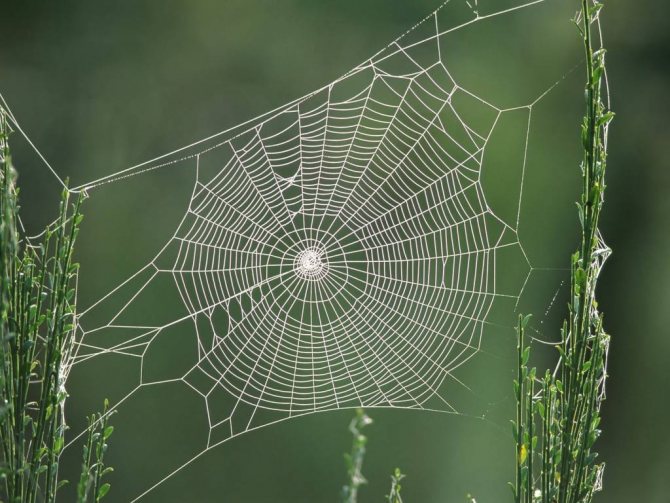

- Spider web in the form of a cone: such a web is woven by a funnel spider. Usually he creates his trapping funnel in tall grass, while he himself hides in its narrow base, waiting for prey.
- The zigzag web is its "author" a spider from the genus Argiope.
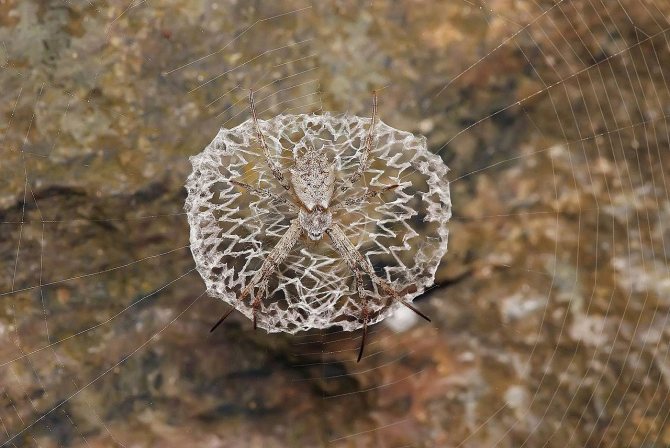

- Spiders from the family Dinopidae spinosa weave a web right between their limbs, and then simply throw it on the approaching victim.
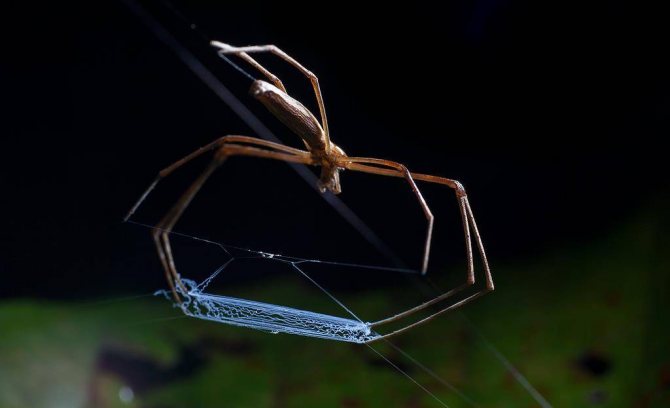

- The Bolas spider (Mastophora cornigera) weaves a string of cobwebs containing a sticky ball with a diameter of 2.5 mm. With this ball, saturated with female moth pheromones, the spider attracts prey - a moth. The victim falls on the bait, flies closer to it and sticks to the ball. Then the spider calmly pulls the victim to itself.
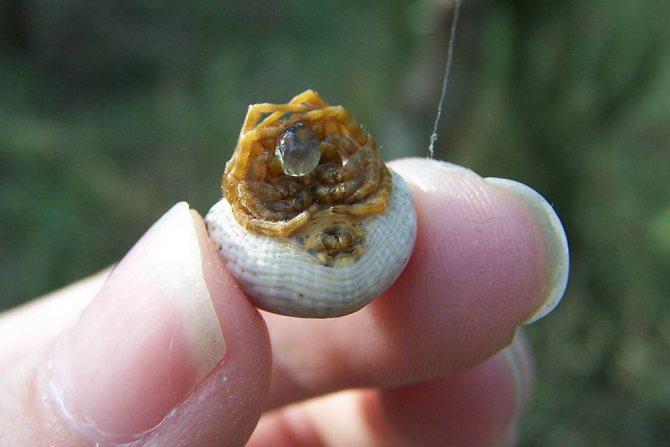

- Darwin's spiders (Caerostris darwini), living on the island of Madagascar, weave giant webs, which range from 900 to 28,000 square meters. cm.
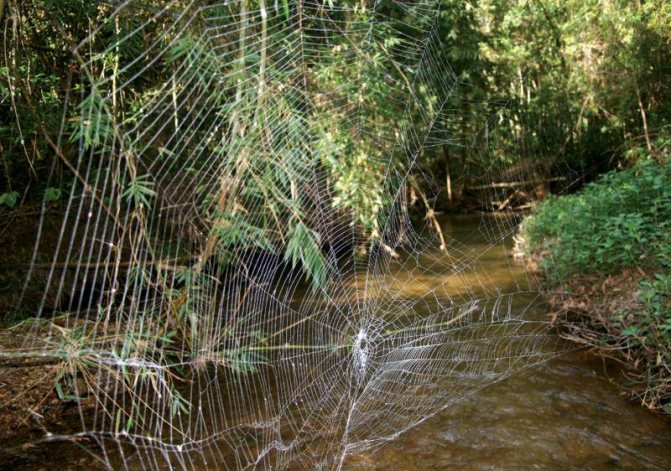

The web can be divided according to the principle of responsibility of its weaving and type:
- household - from such a web, spiders make cocoons and the so-called doors for the dwelling;
- strong - spiders use it to weave nets, with the help of which the main hunt will be carried out;
- sticky - it only goes to the preparation of jumpers in fishing nets and sticks so strongly when touched to it that it is very difficult to remove it.
Names and varieties
In total, scientists have registered and described more than 42,000 species of arachnids. Many adults suffer from a fear of spiders - arachnophobia. About 3000 species of these creatures are found in the territory of the CIS countries.
In this video, you will learn about the strangest spiders in the world:
Blue-green tarantula and flower sidewalker
The blue-green tarantula is considered the most spectacular and beautiful. Its main characteristics:
- carapace of bright green color;
- bright blue paws;
- the abdomen is red-orange;
- limb span up to 15 cm;
- the size of the cephalothorax is about 7 cm.
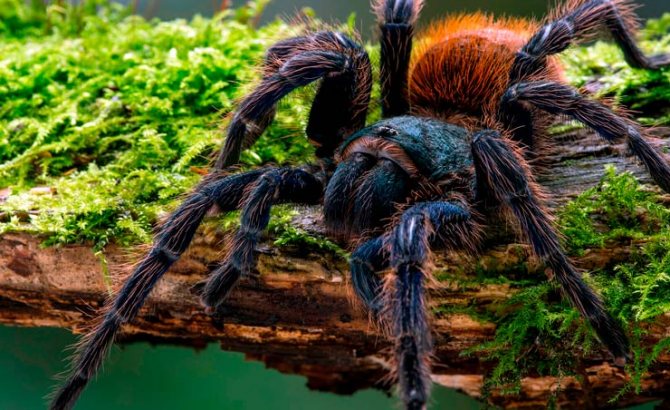

Tarantulas are among the largest spiders
Venezuela is considered the birthplace of this creature. However, tarantula spiders can easily exist on the territory of Africa, as well as in Asian states. This species of arachnids is not capable of harming humans, and only when the danger approaches, the individual shoots out special villi that grow on the abdomen.
The hairs do not pose any danger to human life, but small burns may remain after contact with them. In appearance, the injury is somewhat reminiscent of the consequences of touching nettles. Male tarantula spiders are able to live only 3 years, and the life span of females is up to 12 years.
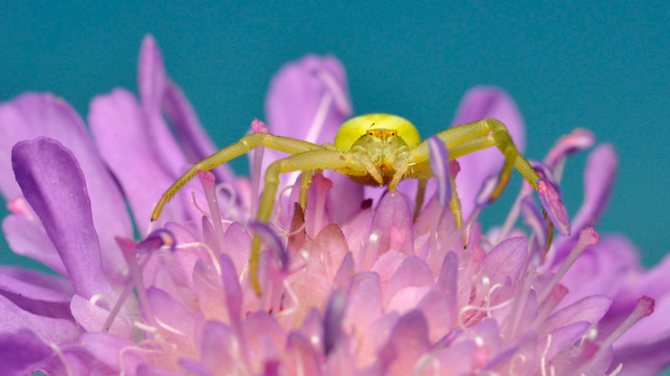

The flower side walker feeds on plant nectar
The color of the flower sidewalk can be different - from pure white to greenish, pink or light green. The maximum length of the cephalothorax is 5 mm in males and 12 mm in females. The species is quite common on the territory of all European states. In addition, the flower spider lives in Japan, Alaska and the United States. Mainly prefers open area with a wide variety of flowering grasses. This is due to the fact that the flower spider consumes the juice of caught butterflies and bees.
Grammostola pulchra and argiope brunnich
Grammostola pulkhra belongs to the group of tarantula spiders, which live in the wild only in southern Brazil and Uruguay. The animal is very large, it grows up to 11 cm in length. It differs from most other species in the beautiful metallic sheen of the hairs and dark colors. In its natural habitat, the spider can be found among the roots of large plants. It is worth noting that these arthropods almost never dig their own burrows. For many lovers of exotic creatures of the gram table, pulchra often becomes a pet.
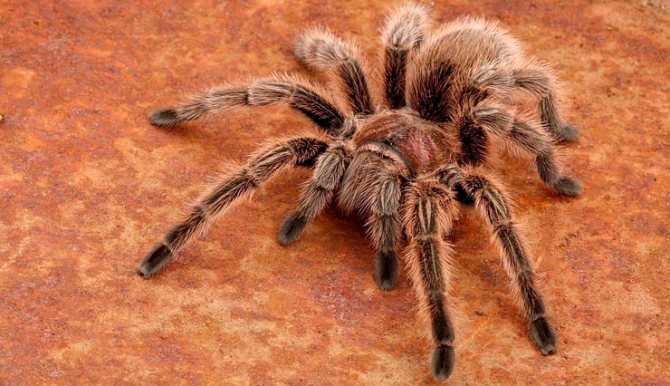

Grammostola pulchra is popular with keeper (spider lovers)
Argiope brunnich, which is also popularly called the wasp spider, has a very unusual coloring of paws and body - in white-black-yellow stripes. Due to this color, it is arachnid and is called a wasp. Males are paler than females. The maximum size of an individual is 7 mm. Spiders are widespread in the northern regions of the African continent, the Volga region, as well as in the southern part of Russia.
You can also meet the agriopa brunnich in the countries of Asia and Europe. Basically, spiders prefer to settle on forest edges, as well as in meadows, where there is a large abundance of herbaceous plants. The cobweb is quite strong, it is almost impossible to break it, it only stretches under pressure.
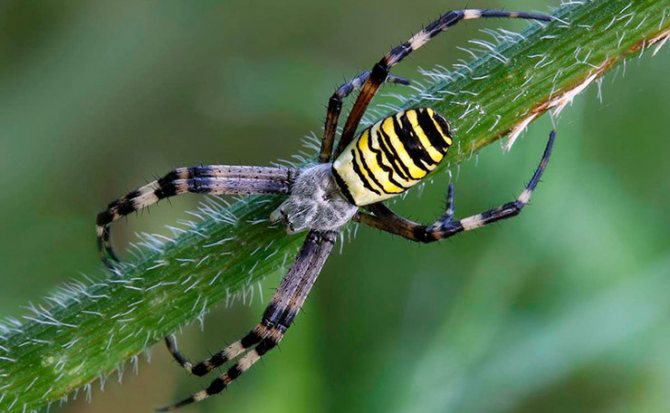

The wasp spider is found in countries with warm climates
Limp hunter and the Apulian tarantula
The limped hunter is quite widespread in Eurasia. They prefer to settle along the banks of reservoirs, where water flows slowly or simply stands. Often arachnids settle in front gardens, where the air humidity is high, in shady groves or in wetlands. The maximum body length of a female is 22 mm, and males do not grow more than 13 mm. Body color is black or yellow-brown. On the side of the abdomen there are light yellow, almost white, stripes.
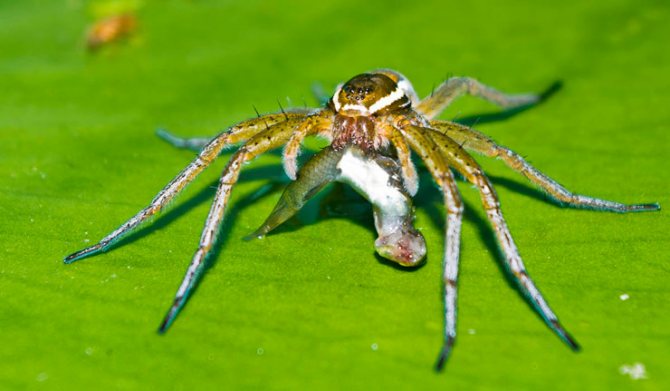

The water spider feeds on fish, which it catches while on the surface of water bodies.
The Apulian tarantula belongs to the family of wolf spiders. Their main range is the countries of Southern Europe:
- Spain;
- Italy;
- Portugal.
These arthropods are able to pull out burrows, the depth of which reaches half a meter. The maximum body length is 7 cm. As a rule, individuals are painted in a red tint, brown spiders are rarely found. A long stripe can be seen on the body, as well as several transverse lines of a light tone.
Spiked orb weaving and peacock
The spiny orb weaver, also known as the horned spider, is widespread in subtropical and tropical regions in Australia, the Philippine Islands, Central America, and the southern United States. Females can grow up to 13 mm wide and 9 mm long. Males are no longer than 3 mm. The limbs are rather short, with 6 spines at the edges. Individuals have a very bright color:
- red;
- the black;
- white;
- yellow.
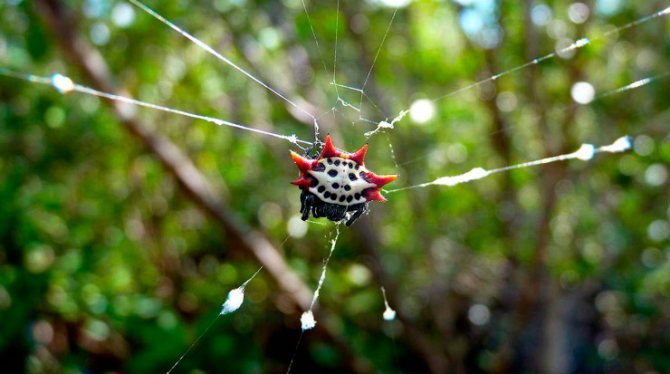

Spiny orb weaving has an extremely unique color and body shape
On the abdomen there is a pattern consisting of black dots.
The peacock spider has a very unusual color, in which you can find almost all the colors of the rainbow: green, yellow, blue, blue, red. At the same time, females have a dull color. Adults can grow up to 20 mm in length. It is with their bright colors that males actively attract females during the mating season. Distributed in Australia.
Smiling spider and black widow
Smiling spider, which is also called the "happy face spider", poses absolutely no danger to humans. The main habitat of these arachnids is the Hawaiian Islands. The maximum body length is 5 mm. The color can be varied from blue to bright yellow. Spiders eat small midges. The bright colors help the smiling spider confuse its enemies, which are mostly birds.
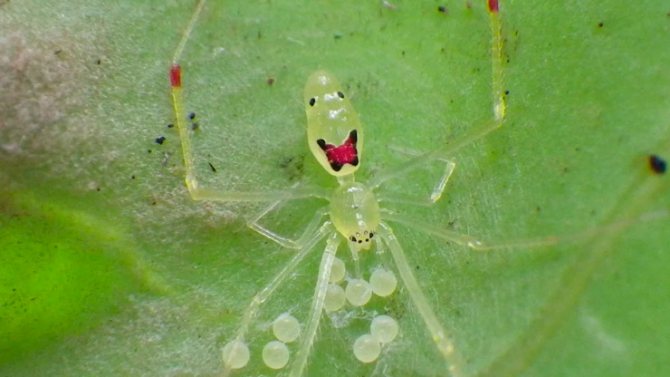

The smiling spider is known for its matching body coloration.
Black widow - a very poisonous and dangerous species for humans. It mainly lives in North America, Australia, however, cases of the presence of this arthropod in Russia have been noticed, despite the fact that the Russian climate is not particularly favorable for them. Females reach 1 cm in length, males are smaller. The body and limbs are black, with a bright red hourglass pattern on the abdomen. Males have a different color: brown with white lines. The bite of one arthropod can even cause death, especially if the individual attacks a small child.
There are other types of spiders that a person should be afraid of. It is impossible not to mention karakurt - a relative of the black widow. Females grow up to 2 cm in length, and the maximum size of a male is 7 mm. There are 13 scarlet spots on the abdomen. Some types of karakurt spots have a border.
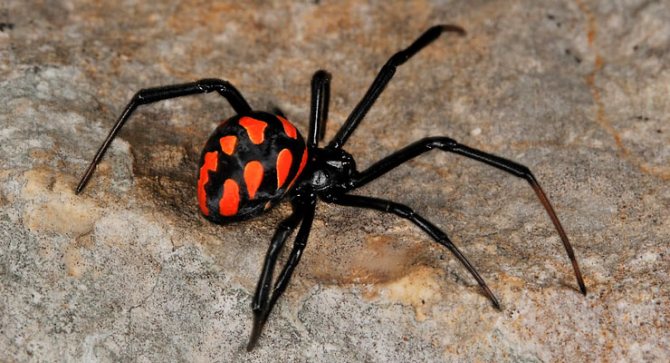

The black widow is a rather dangerous spider because of its venom. Found in warm countries
In mature individuals of certain breeds, these spots are completely absent, and the body has a shiny black color. These arthropods are common in the northern regions of the African continent, in the southern territories of European states, in the Black Sea region in the Azov region, in the southern regions of Ukraine and Russia, as well as in some countries of Central Asia.
Spider description
Spiders have 8 legs. The body is divided into 2 parts, they are connected by a thin stalk. Most spiders have 8 eyes, some have 6. A few arachnids outside Europe have 4 or 2 eyes. Spider eyes do not have one location, it depends on the species. Some spiders have the same eye size, others have different ones. Most spiders have poor vision. But some species have large front eyes with fairly good vision:
The easiest way to tell if an arachnid is male or female is to look at the front tentacles. In females, they are rather narrow; in spiders, the tips of the tentacles resemble boxing gloves. Males use them as pipettes to extract sperm during mating.
What spiders are endemic to Russia and Europe, the most common species
Interesting Spider Facts
- According to statistics, 6% of the world's population suffers from arachnophobia - the fear of spiders. Particularly sensitive natures panic when they see a spider in a photo or on TV.
- Frightening-looking spiders - tarantulas, having a paw span of up to 17 cm, are actually calm and non-aggressive, thanks to which they have earned the fame of popular pets. However, the owners must protect their pets from stress, otherwise the spider sheds its bright hairs, which cause an allergic reaction in humans.
- The most poisonous spiders are black widows, their variety is karakurt, as well as Brazilian soldier spiders. The venom of these spiders, containing powerful neurotoxins, instantly attacks the victim's lymphatic system, which in most cases leads to cardiac arrest.
- Many people mistakenly believe that the poison of a tarantula is fatal to humans. In reality, a tarantur bite causes only slight swelling, similar to a wasp sting.
- Wall crab spiders, named in Latin Selenopidae after the Greek goddess of the Moon, move sideways as well as backwards.
- Jumping spiders are excellent jumpers, especially over long distances. As a safety net, the spider attaches a silk spider thread to the landing site. In addition, this type of spider can climb glass.
- In pursuit of a prey, some species of spiders can run almost 2 km in 1 hour without stopping.
- Fishing spiders have the ability to slide along the water surface like water striders.
- Most spider species have an individual woven web shape. House (funnel) spiders weave webs in the form of a funnel, angular webs are characteristic of diktin weaver spiders. The web of Nicodemus spiders is like a sheet of paper.
- Lynx spiders are distinguished by a property uncharacteristic for spiders: while protecting the clutch, females spit at the threat of poison, although this poison does not pose a danger to humans.
- Female wolf spiders are very caring mothers. Until the children gain independence, the mother "carries" the cubs on her. Sometimes there are so many spiders that only 8 eyes remain open on the spider's body.
- The New Zealand burial spider is immortalized in the cinema thanks to director Peter Jackson, who used this species as the prototype of the spider Shelob.
- Very beautiful flower spiders lie in wait for prey on flowers, and adult females, as a disguise, change their color depending on the color of the petals.
- The history of mankind is closely intertwined with the image of the spider, which is reflected in many cultures, mythology and art. Each nation has its own traditions, legends and signs associated with spiders. Spiders are even mentioned in the Bible.
- In symbolism, the spider personifies deceit and immense patience, and the spider's venom is considered a curse that brings misfortune and death.
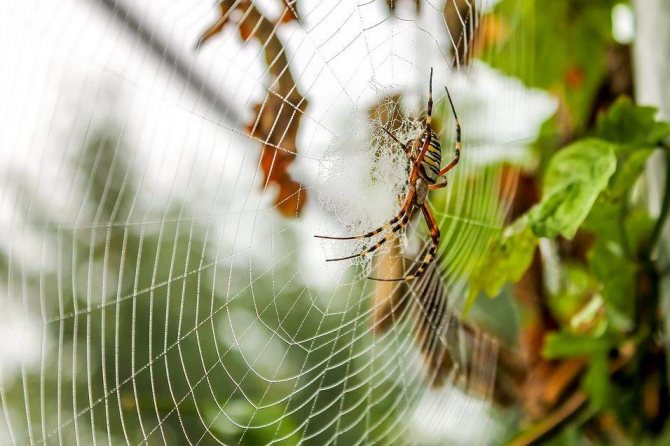

Did you like the article?
What are the consequences of the bite of this spider?
An employee of the Department of Invertebrate Zoology at St. Petersburg State University says that redness and swelling develop at the site of the bite, and that severe pain quickly develops, which can spread to the limbs, lower back, chest, and abdomen. A person who has been bitten may experience weakness, nausea, headache, he may experience strong mental agitation, a feeling of fear, suffocation. Some have convulsions, arrhythmias. Recovery usually occurs only after two to three weeks; weakness may persist for a long time after the bite (up to one or two months).
“The consequences of a bite depend on many factors: what kind of karakurt it was (the most toxic are large mature females); it matters how toxic the venom was in a particular spider, as well as the site of the bite - a bite in the arm or leg may not have such serious consequences as in the chest; the individual susceptibility of a person is also important - for example, someone may be allergic to the components of the poison. In this case, the consequences can be more severe. According to rough estimates, in people bitten by karakurt who did not receive treatment at all, about 2% of cases ended in death, ”says Repkin.
The expert adds that not only people, but also livestock that graze in the habitats of the spider often suffer from karakurt bites. First of all, these are horses, camels, sheep and goats.
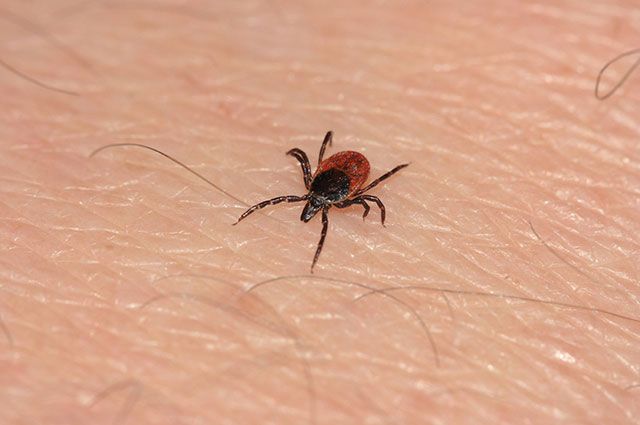

Where does the black-footed tick come from in the Moscow region? More details

